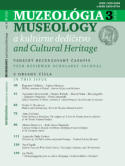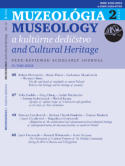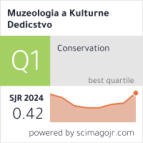

MUZEOLÓGIA
MUSEOLOGY
a kultúrne dedičstvo
and Cultural Heritage

News
Journal Muzeológia a
kultúrne dedičstvo -
Museology and Cultural
Heritage:
SJR 2024: 0,424 (Q1)
Museology SJR rank: 8/83 (Q1) Conservation SJR rank: 11/103 (Q1)JIF WoS 2023: 0,6
JCI WoS 2023: 1,28, Q1 ESCI: 49/411 (Q1)New issue
Muzeológia a kultúrne
dedičstvo 2/2025
online New volume Studia Museologica Slovaca, vol. 8 (2024) online New volume Populačné štúdie Slovenska 17 (2024) onlineNew book
P. Tišliar (ed.). Osobnosti uměleckoprůmyslového muzejnictví (2025) online
Contents 2/2024
Title: The life and death of windmills in central Poland: Between lost heritage and the heritage of
memory
Abstract: Windmills are one of the most complex human inventions of the pre-industrial era. Making use of wind energy to serve
human needs was not only a miracle of architecture and technology: it produced silent witnesses of history – an important part of a
rural landscape, local identity and folklore. Thanks to their multiple roles, windmills are useful research objects for scientists in various
fields. In Poland the first written records of windmills date from the (many of them still fully operational) despite losses in the war.
Today there are around 250 windmills under legal protection (around 70 of which were moved to open-air museums). This figure
illustrates the vulnerability and progressive disappearance of Poland’s windmills.
Despite the efforts made to protect this heritage, often the only remnants of such objects are the memories people living nearby.
These memories join the present with the past, recall people and their work, and preserve the memory of an item. Windmills that have
ceased to exist are still present in people’s collective remembering as a sum of their subjective experiences and impressions. In this
paper, we decided to combine different approaches to the matter of heritage – both tangible and intangible. We argue for the
importance of collecting recollections of ordinary people and interviews with eyewitnesses, as well as examples of institutional or
private efforts made to protect windmills, to explain the equal value of both of these methods for preserving memories about the work
and skills of millers – that is, the memory of a profession that was once a vital part of cultural identity.
Authors: Piotrowski, Robert1; Prarat, Maciej3; Mosakowski, Zachariasz2; Bartz, Wojciech4
Publication order reference:
1Laboratory for Interdisciplinary Research into the Anthropocene, Institute of Geography and Spatial Organisation of the Polish Academy of Sciences in
Warsaw, Kopernika 19, 87–100 Toruń, Poland, e-mail: robert@geopan.torun.pl, https://orcid.org/0000-0002-0499-3463
2Laboratory for Interdisciplinary Research into the Anthropocene, Institute of Geography and Spatial Organisation of the Polish Academy of Sciences in
Warsaw, Kopernika 19, 87–100 Toruń, Poland e-mail: zachary@twarda.pan.pl, https://orcid.org/0000-0001-9688-1495
3Nicolaus Copernicus University, Faculty of Fine Arts, Department for the Study and Protection of Cultural Heritage, Sienkiewicza 30/32, 87-100 Toruń, Poland,
e-mail: mprarat@umk.pl, https://orcid.org/0000-0001-7076-2009
4University of Wroclaw, Cybulskiego 30, 50-205 Wrocław, Poland, e-mail: wojciech.bartz@uwr.edu.pl, https://orcid.org/0000-0002-7267-2776
Source: Muzeológia a kultúrne dedičstvo, year: 2024, vol.: 12, issue: 2, pages: 5-25.
Key words: windmills, industrial herotage, heritage of memory, Poland
Language: English
online full-text PDF
doi: 10.46284/mkd.2024.12.2.1
Title: Specifics of stylised shapes of Chinoiserie-style pavilions as the basis of their restoration
Abstract: This article analyses the phenomenon of Chinoiserie style in European architecture. The basic principles of Chinese
landscape design and the role of pavilions in the natural environment are highlighted. The fundamental difference between European
and Chinese pavilions is shown at different levels – from the structure of the park to the composition to individual details – and it is
also shown that European Chinoiserie-style pavilions were a much simplified and averaged version of the Chinese ones.
The ambiguity of purpose and variety of functions inherent in ancient Chinese pavilions are lost in European ones, as the “Chinese-
style” pavilion is intended for only one purpose – aesthetic entertainment. The appearance of the European pavilion, sometimes called
a “tea pavilion”, does not follow that of ancient Chinese tea ceremony pavilions. In addition, the European park pavilions cannot be
compared to the most famous Chinese “landscape pavilions”, as none of the former are located in such a majestic landscape with the
possibility of viewing from a long distance.
Authors: Ivashko, Yulia1; Chang, Peng2; Dmytrenko, Andrii3; Kobylarczyk, Justyna4; Krupa, Michał5
Publication order reference:
1 Kyiv National University of Construction and Architecture, Ukraine, e-mail: yulia-ivashko@ukr.net, https://orcid.org/0000-0003-4525-9182
2 Kyiv National University of Construction and Architecture, Ukraine, https://orcid.org/0000-0001-7772-5200
3 National University “Yuri Kondratyuk, Poltava Polytechnic”, Ukraine, email: metr5555@ukr.net, https://orcid.org/0000-0003-4757-5218
4 Cracow University of Technology, Faculty of Architecture, Poland, e-mail: justyna.kobylarczyk@pk.edu.pl, https://orcid.org/0000-0002-3358-3762
5 Cracow University of Technology, Faculty of Architecture, Poland, e-mail: michal.krupa@pk.edu.pl, https://orcid.org/0000-0002-2199-0598
Source: Muzeológia a kultúrne dedičstvo, year: 2024, vol.: 12, issue: 2, pages: 27-41.
Keywords: Chinese pavilion, Chinoiserie, stylised forms, restoration
Language: English
online full-text PDF
doi: 10.46284/mkd.2024.12.2.2
Title: Adaptation of the architectural and infrastructural post-industrial heritage of underground
mines for museum functions in southern Poland
Abstract: This article addresses the problem of developing disused underground mines for museum purposes in cities and towns in
southern Poland. Following the reduction in mining activities and the collapse and liquidation of many industrial plants in the region –
developments related to both the global situation and the political transformation of the late twentieth century – many localities lost
their previous economic basis for development. One of the strategies often used in such situations is revitalisation through culture.
Establishing museums in underground mines, which in southern Poland have a history dating back to the eighteenth century, has
gained popularity in recent decades. The authenticity of the preserved architectural and infrastructural heritage helps to preserve the
identity of the regions by displaying the mementos and achievements of past generations in an appropriate manner. Most of the sites
discussed in the paper, three of which are on the UNESCO World Heritage List, use this method of display, enriching the facility’s
programme with other elements. There is also a strategy to transform these post-industrial resources to a much greater extent and
adapt them to modern functions using contemporary architectural solutions, while preserving the most valuable elements of their
architectural and infrastructural heritage.
Author: Gyurkovich, Mateusz1; Uherek-Bradecka, Barbara2; Bradecki, Tomasz3; Gyurkovich, Jacek4; Gyurkovich, Magdalena5
Publication order reference:
1 Cracow University of Technology, Faculty of Architecture, Poland, e-mail: mateusz.gyurkovich@pk.edu.pl, https://orcid.org/0000-0003-2167-6424
2 Academy of Silesia in Katowice, Faculty of Architecture, Civil Construction and Applied Art, Poland, e-mail: barbara.bradecka@wst.com.pl,
https://orcid.org/0000-0001-8222-1488
3 Silesian University of Technology, Faculty of Architecture, Poland, e-mail: Tomasz.bradecki@polsl.pl, https://orcid.org/0000-0002-9459-4545
4 Academy of Silesia in Katowice, Faculty of Architecture, Civil Construction and Applied Art, Poland, e-mail: jacek.gyurkovich@akademiaslaska.pl,
https://orcid.org/0000-0003-3920-445X
5 Poznan University of Technology, Faculty of Architecture, Poland, e-mail: magdalena.gyurkovich@put.poznan.pl, https://orcid.org/0000-0003-4275-0435
Source: Muzeológia a kultúrne dedičstvo, year: 2024, vol.: 12, issue: 2, pages: 43-64.
Keywords: post-industrial architectural heritage, post-industrial infrastructural heritage, architectural adaptation, museums in mines,
southern Poland
Language: English
online full-text PDF
doi: 10.46284/mkd.2024.12.2.3
Title: The Destruction of Cultural Property of the Muslim Community during the War in Bosnia and
Herzegovina
Abstract: The purpose of this work is to present the process of the destruction of cultural property of the Muslim community during the
warfare conducted on the territory of Bosnia and Herzegovina (BiH) in 1992–1995. The work is based on historical and press sources
in Serbian, Bosnian and Croatian. Field research conducted in 2000 and 2022 to obtain information on the number of demolished and
restored mosques in BiH also makes an important contribution. In addition, in-depth interviews were conducted with Slovak soldiers
who served in NATO IFOR operations, as well as with representatives of international institutions. Research results indicate that
during the war in BiH (1992–1995) the Muslim community suffered the greatest losses of cultural property. 614 mosques were
destroyed. Serbian armed troops carried out most of the damage, while Croatian armed troops did less. After the war, no individual
was held responsible for the destruction of cultural property. The case of BiH shows that international law still does not protect
religious sites.
Authors: Dworzecki, Jacek1; Wiśniewski, Bernard2; Kujawa, Karol3
Publication order reference:
1 Military University of the Land Forces, Poland, e-mail: jacekdworzecki@o2.pl, https://orcid.org/0000-0002-9357-5713
2 WSB University, Dąbrowa Górnicza, Poland, e-mail: bwisniewski@wsb.edu.pl, https://orcid.org/0000-0002-0011-7271
3 WSB University, Dąbrowa Górnicza, Poland e-mail: kkujawa@wsb.edu.pl, https://orcid.org/0000-0003-3035-0151
Source: Muzeológia a kultúrne dedičstvo, year: 2024, vol.: 12, issue: 2, pages: 65-75.
Keywords: war, threat, law of war, cultural assets, religious communities, conflict
Language: English
online full-text PDF
doi: 10.46284/mkd.2024.12.2.4
Articles (Abstracts)

Full-text version
DOI:10.46284/mkd.2024.12.2.0
ISSN 1339-2204
eISSN 2453-9759
EV 1/22/EPP
Vol. 12 (2024), No. Is. 2



























